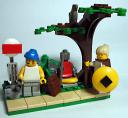|
Building / Vignette / FAQ | |
| Vignette FAQ (Frequently Asked Questions) Updated: 2006-06-22 Welcome to the .vignette FAQ. Here you will find some general information and guidelines on vignettes and vignette building. Suggestions for this FAQ can be made to the curators Q: What is a Vignette? A: The word ‘vignette’ comes from the old French word ‘vigne’, which means vine. A vignette is the fancy, decorative design often found at the beginnings or ends of old books/manuscripts, describing the vine-like tendrils of the artwork or lettering used in decorative borders. Over time, the word vignette also came to mean ‘an unbordered picture’, then as ‘a short, literary sketch, or a short scene, as from a movie’. In terms of LEGO, a vignette is basically a MOC built on a small base. How small? Well, see below. To paraphrase Bruce Hietbrink in the first post to this newsgroup: “Small scenes built on small bases. They capture a slice of life, tell a small story in a scene, or provide a bit of humor. The small size encourages creativity, and allows fans with small collections to contribute. Quick to build, but long on thought, the emphasis with these models is FUN. Another way of describing a vignette is that it is a MOC you would place on your desk or shelf for viewing. It is not really designed for play, nor the movement of the pieces/minifigs, as most other MOCs are. Q: What is a Vig? A: Vig is simply an abbreviation for Vignette. Q: Is there a set scale for building Vignettes? A: No. Many LEGO fans have come to identify a vignette as being a MOC with a 6x6 or 8x8 stud base. Moreover, the 8x8 has become the accepted ‘standard’ in vignette building. However, to inspire more creativity (and hopefully more vignette MOCs from YOU who are reading this), we have set up a few guidelines/descriptions of what could also be categorized as vignettes. The intent is not to set any rules or limitations, but rather to help everyone understand that vignette building can be fun and innovative, and is limited only by your imagination and creativity. Size Chart for Vignettes:
[Note: These examples are based on bases with EVEN-numbered studs. You can have an ODD-numbered stud base on your vignette as well.] So how big is TOO big? Well, most people would generally agree that a 32x32 stud MOC would not be considered a vignette. So, as a guideline, a vignette should generally be on a base of no more than 256 studs (16x16). Again, this is only a guideline. Q: What about the height of a vignette? A: There are no limitations on height, as long as it is essential to the essence of the vignette. Ley Ward demonstrated extreme height in his vignette “Jumper”: 
Q: What makes for a good vignette: A: A good vignette should...
Q: Can a piece extend out beyond the base? A: Yes. As a guideline, objects should extend out from the base no more than 4 studs. However, some MOCs may require parts that extend father from the base than 4 studs, due to the inherent length of the part, and/or its requirement as an essential part of the vignette. As long as it contributes to what the vignette represents, it is acceptable. (Note: A tree built on a 6x6 base, with branches extending out to form a 32x32 stud canopy would not be considered a vignette... and can easily topple over as well.) Q: What is a Modular Vignette (Vignette Model): A: A Modular Vignette (or Vignette Model) is a group of 2 or more individual vignettes that come together to form a model, such as a building, or a larger scene such as a sidewalk or road. The very first can be credited to Sugesaya, who linked 2 of his 6x6 vignettes (Busstop and Solitary Journey) in this image: 
Q: Who created the first LEGO vignette? A: Unknown. It seems that the vignette trend started in Japan, and not necessarily in the LEGO community. Bruce Hietbrink first brought LEGO vignettes to the attention of the LUGNET community in this post in September, 2004. Q: Are there any official LEGO vignette sets that I can purchase? A: At this time, there are no official LEGO vignette sets, per se. However, there are quite a number of sets that appear to have vignette-like qualities, such as these Star Wars sets:  
Q: Can anyone build a vignette? A: Yes. Now go build one! |
|
All text, images, or trademarks in this document are the intellectual property of their respective owners. |
| |
©2005 LUGNET. All rights reserved. - hosted by steinbruch.info GbR |